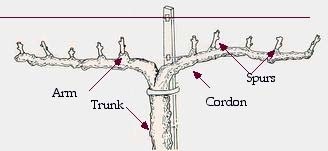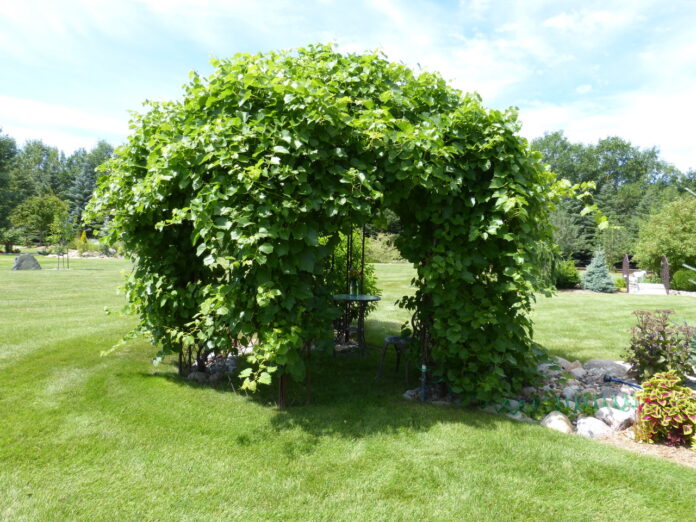by Sara Williams and Bob Bors
Saskatchewan Perennial Society
This is the second part of an article on grape growing. For part one, see the June 24 edition of Rural Roots.
Watering is important the first year or two, until the roots develop. Grape roots are both deep and extensive and the plants will need little supplemental water unless it is very dry. If soil fertility is poor, top dress them with an organic mulch a few inches deep applied to a metre diameter around the base of the plant. Grapes have few problems although powdery mildew and spider mites are sometimes present.
Training and Pruning There are many ways to train grapes. To cover a low deck or a patio, using a large trellis structure, choose the hardy and vigorous variety ‘Valiant’. The result will be highly ornamental and provide shade but may not produce the highest quality grapes because many will be shaded.
Build the trellis using heavy gauge wire with metal or wooded fence posts. Place the posts a meter or two apart with the grapes planted between the posts. Using a few wires makes pruning much easier than if the vines are growing on a chain link fence, a deer fence or another more complicated structure. Three wires parallel to the ground provide an ideal support which encourages short plants with permanent arms on the lowest wire. Any snow that accumulates will insulate the vines and often the first arms.
Do not prune grapes while the sap is running in spring as they will “bleed” for several days, wasting sap that is full of sugar, carbohydrates and other nutrients that should be going into the formation of fruit, leaves and shoots.

1st Year: Allow the vines to grow with no pruning. This will encourage maximum root establishment. Any vines that crawl around on the ground should be lifted up onto a trellis, fence or other support.
2nd Year: Before growth begins in spring, choose the strongest “cane” (grape talk for an individual vine) and cut it back to about 4 or 5 buds. Remove all of the other canes. Growth will be very fast. Within a couple weeks choose one of the shoots to form the new trunk keep other shoots. one or two of those to serve as backups for the new main trunk. The backups should be regularly trimmed to only a few nodes so as not to compete with the trunk. When the main shoot reaches the lower wire, pinch it to encourage more canes to form. Once they have formed, select two canes, one for each arm (to the right and to the left). Remove all other shoots except the backups.
3rd Year: During the winter, cut back each arm to about 10 buds. Also leave two renewal spurs closer to the trunk. Renewal spurs are canes of young wood that have only 2 buds. They will make new wood to be used the following year to form the new arms. Fruit production usually begins during this third season.
As the vines climb up the trellis, grapes are formed mostly from the arms and should hang just below the bottom and middle of the three wires. The vines will continue growth onto the top wire. Trimming out some of the vines or removing some of the leaves through the summer reduces leaf diseases by increasing air circulation. It also increases sunlight penetration that should result in more even (and possibly earlier) ripening.
4th year and beyond. Each year prune back the vines to new wood as close as possible to the main trunk. A common method is to leave four young canes with five or 6 buds each. Another method is to leave one or two arms with many short canes of young wood that may have only 2 buds each.
This column is provided courtesy of the Saskatchewan Perennial Society (SPS; saskperennial@hotmail.com ). Check our website saskperennial.ca) or Facebook page (facebook.com/saskperennial). All Saskatchewan Perennial Society events are on hold until further notice.


